Protected bays with turquoise water and coral fringe reefs. Active Volcanoes. Marine sanctuaries. Sacred historical sights. There are so many unique and beautiful Hawaii landmarks to see on Maui, Kauai, Oahu, and Big Island, Hawaii!
Whether it’s unique geological formations or a walk back through history you’re interested in, it’s going to be challenging to decide on the best place to travel in Hawaii! Here are the best of the best, organized by every island.
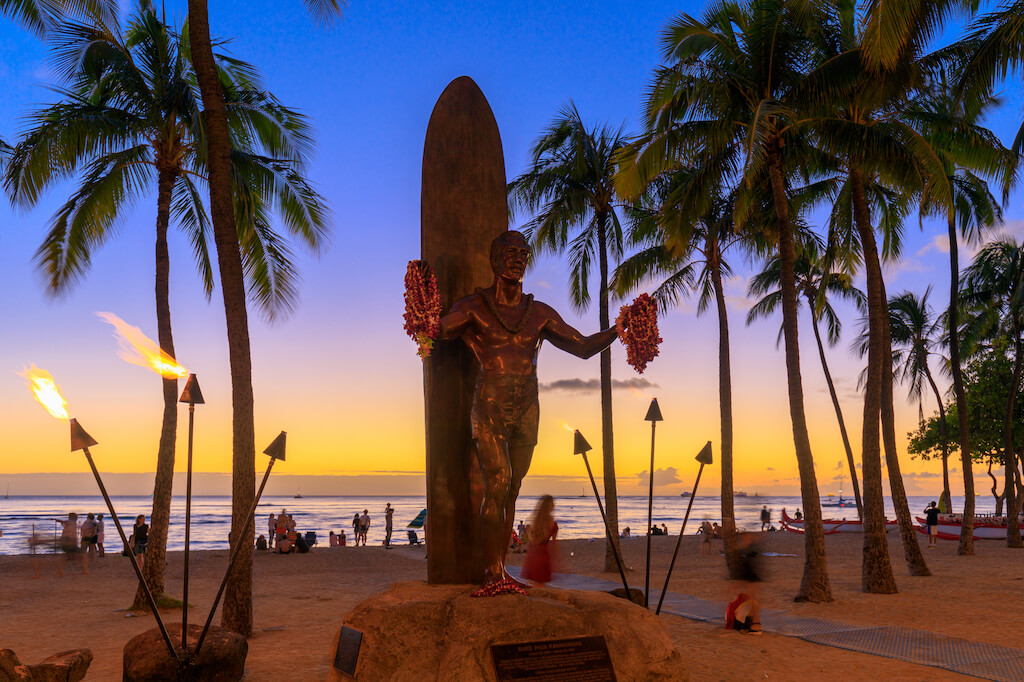
Map of Hawaii Landmarks
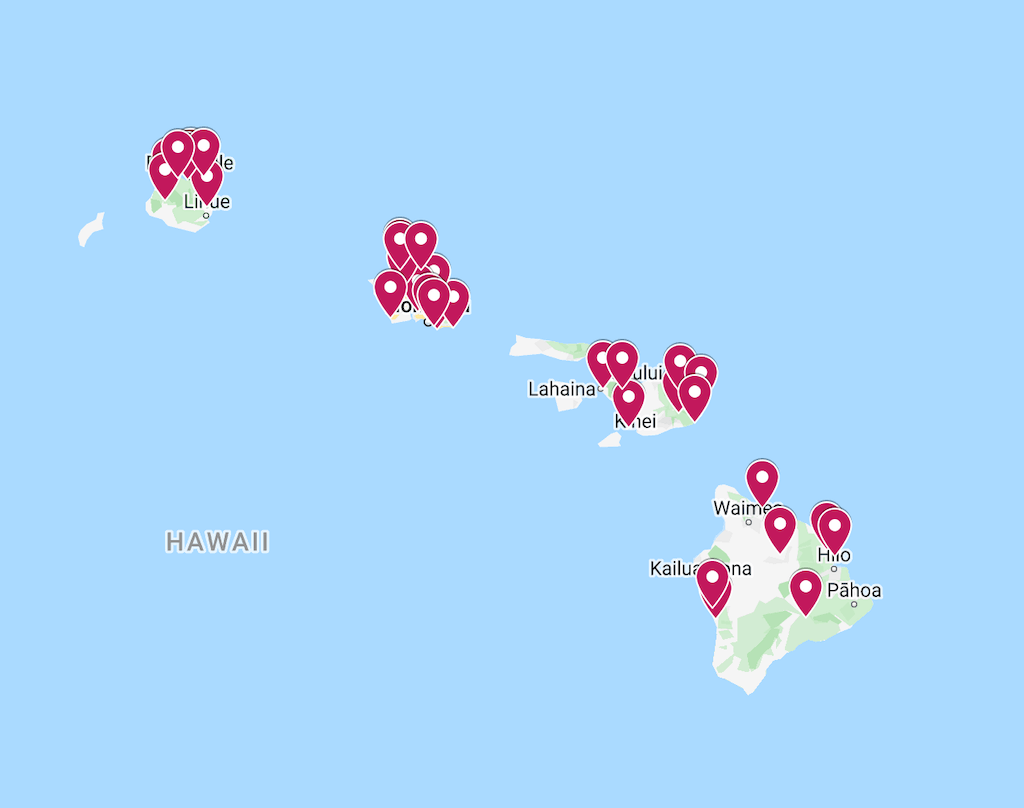
How to use this map: This map is an image. Click the map to open an interactive version of the map. From there, if you click “open in my maps”, you can add this to your Google maps. Just click the tiny transparent star to the right of the map description to save it in “your places.” Go to “your places” next and there it is!
Hawaii Landmarks
Maui Landmarks
1. Road to Hana
Maui’s incredible Road to Hana stretches more than 64 miles between Kahului and Hana along the eastern coat of Maui and is one of Hawaii’s most famous landmarks!
Why? Because it’s a full day drive with some epic sights! It’s one of the top things to do in Maui.
There are 59 bridges here that hug the coast past black sand beaches, waterfalls, rainbow Eucalyptus trees, and scenic bays.
Most visitors drive the road in one long day trip but smart travelers plan one overnight in Hana to enjoy the peace and quiet of this magical place after the daytrippers have headed home. (See my post on where to stay in Maui.)
It’s about the journey, not the destination here…planning lots of stops for hikes, waterfalls, and viewpoints. If you’d rather leave the driving to someone else, book this guided day tour.
Don’t miss the black sand beach at Waiʻānapanapa State Park. See #3 below.
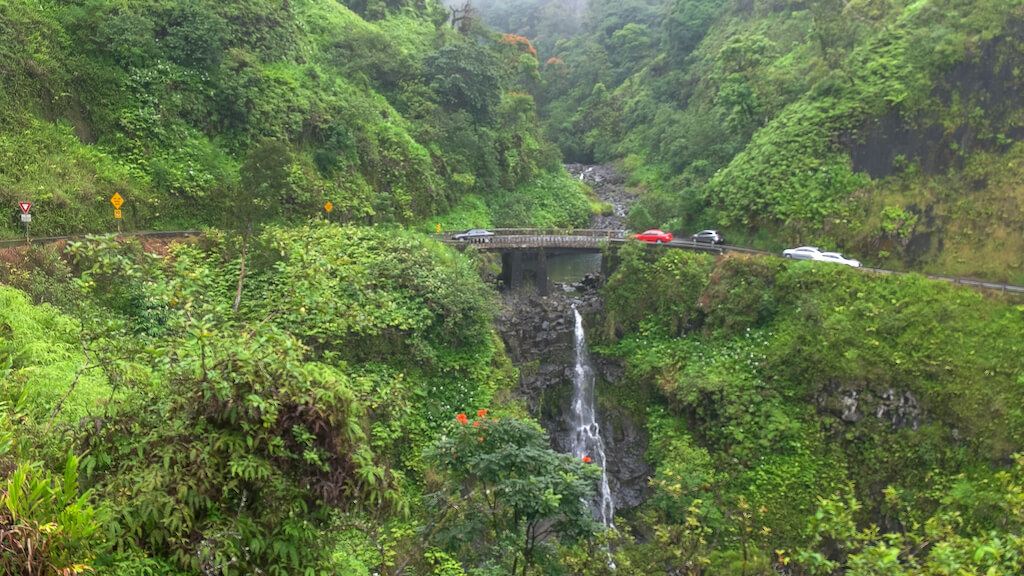
2. Haleakala National Park
A visit to the otherworldly Haleakala National Park is a must on any Maui itinerary. The park includes Maui’s highest peak!
It’s a biosphere reserve that supports native ecosystems in a mature volcanic landscape.
Look for Hawaiian Silverswords here…spikey plants growing on the ground that looks like they’ve been spraypainted silver.
At higher elevations, Haleakala looks a bit like a moonscape. It’s also home to dozens of Hawaiian legends.
Halakea means “house of the sun” and is where the demigod Maui threw a lasso around the sun to slow its movement across the sky so that villagers had more time to grow food.
The most popular time to visit Mount Haleakala is at sunrise—reservations required—but for fewer crowds and a later start time, head here in late afternoon for a hike and sun set. You can book a guided day tour here.
(Add a puffy jacket to your Hawaii packing list!)
You’ll wind your way through the middle of Maui, known as Upcountry, all the way up to the summit. Expect lots of wind…and possibly rain and fog.

3. Molokini Crater
Just off Maui’s west coast is another one of Maui’s popular landmarks: Molokini Crater.
In Hawaiian legend, Molokini was a beautiful woman competing with the fire godesss Pele over a love interest. (Don’t mess with Pele. She cut her rival in two and turned her to stone.)
Snorkeling Molokini is one of the most popular day tours on the island. Choose a smaller catamaran for a more intimate experience. You can book a tour here.
This crescent-shaped island is actually a partly submerged volcanic carter, here in the ‘Alalākeiki Channel.
The shape of the crater protects divers and snorkelers from big waves and stiff currents.
And it’s basically like snorkeling in an aquarium of tropical fish. The wind kicks up here in the afternoons though so always book a morning tour for best conditions.
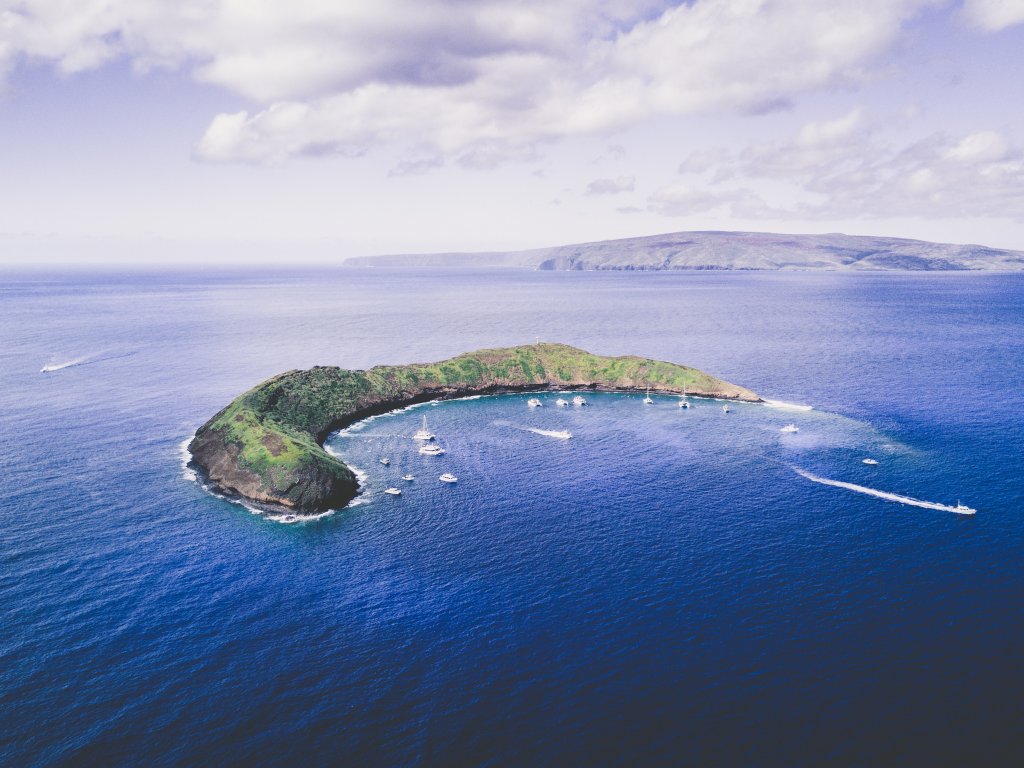
Read more on Hawaii travel:
• How to choose which Hawaii island to visit
• The Ultimate Hawaii bucket list
• Hawaii travel tips for first time visitors
• How to plan a Hawaii trip
4. Waiʻānapanapa State Park
You’ll find the breathtaking black sand beach at Waiʻānapanapa State Park at mile marker 32 on the Road to Hana. It’s the main black sand beach on Maui!
And it’s worth your time. Black sand beaches are formed by lava flow (unlike white sand beaches which are formed by disintegration of shells).
To make it here on a day trip, you’ll need to drive a good portion of the way to Hana and limit other stops in order to have enough time to make it back to Kahului or wherever you’re staying on the west side of Maui.
Because this is such a scenic and popular spot, reservations are now required to park at the beach so plan ahead. (You can reserve 30 days ahead.)
This is a great place for a picnic or walk along the lava shelf. You’ll find freshwater pools and ocean caves here, too!
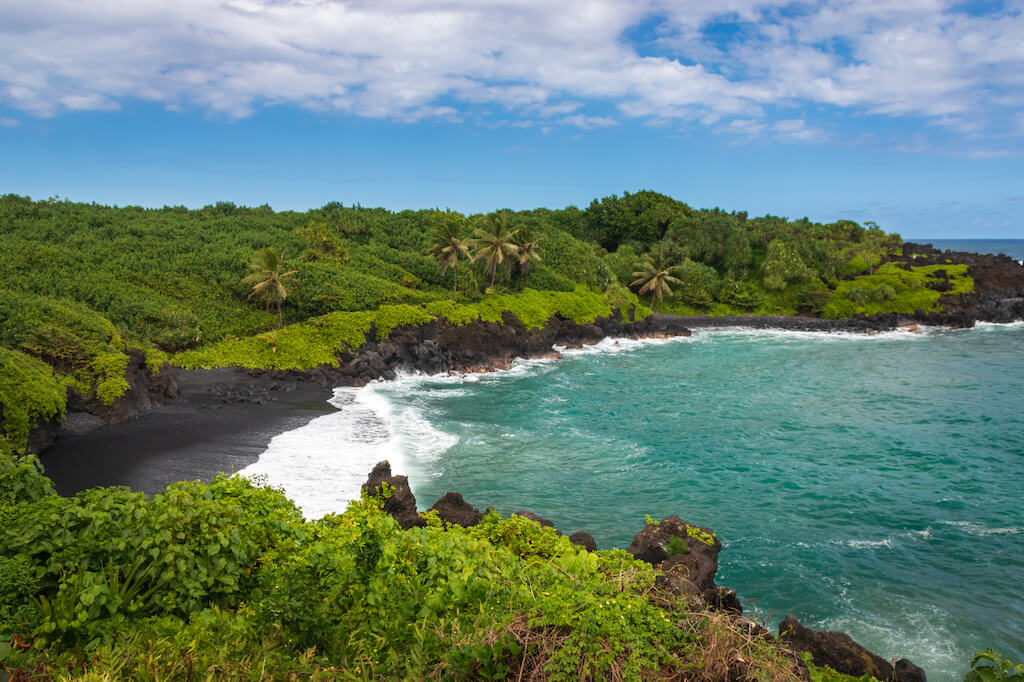
5. Lahaina Historic District
As many visitors spy the sign for Lahaina on the west side of Maui, Loggins & Messina lyrics come to mind (“I was sitting at a table on an open bay, waiting for a drink of rum…”)
Lahaina makes a great base for your Maui adventure. It’s convenient to all of the best beaches. Plus, in winter, whale watching tours depart from here.
Many moons ago, Lahaina was known as “Lele”, or cruel sun in Hawaiian, due to the lesser rainfall here.
Its historic Front Street dates back to the early 19th century. Today, it’s home to colorful boutiques and art galleries.
You’ll also find lots of food trucks within walking distance!
Whatever you do, don’t miss the famous banyan tree at Banyan Court Park in Lahaina.
Spanning nearly two acres and rising up more than 60 feet, it’s the largest banyan tree in the entire United States, making it a Hawaiian landmark not to be missed.
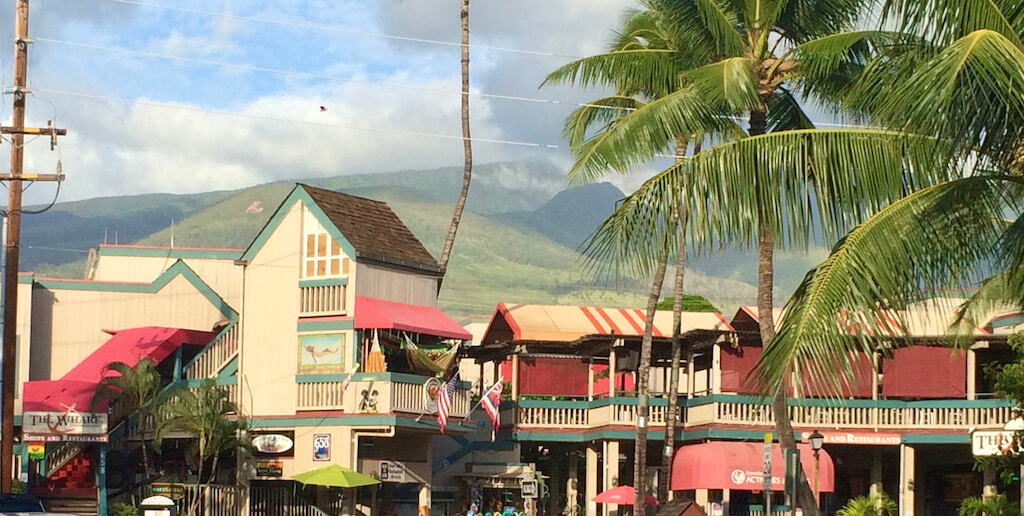
6. ‘Ohe‘o Gulch (Seven Sacred Pools)
‘Ohe‘o Gulch (or Seven Sacred Pools as this area was once called by locals in a creative bid to lure tourists to this remote location) is past Hana.
You’ll actually find more than seven pools here when water levels are up, all fed by waterfalls.
Pīpīwai Trail above this landmark is one of the most beautiful hikes on Maui. (The trail is four miles out and back…or 2.5 hours round-trip.)
But getting here is only doable if you overnight in Hana. It’s just too far if you’re driving the Road to Hana as a day trip.
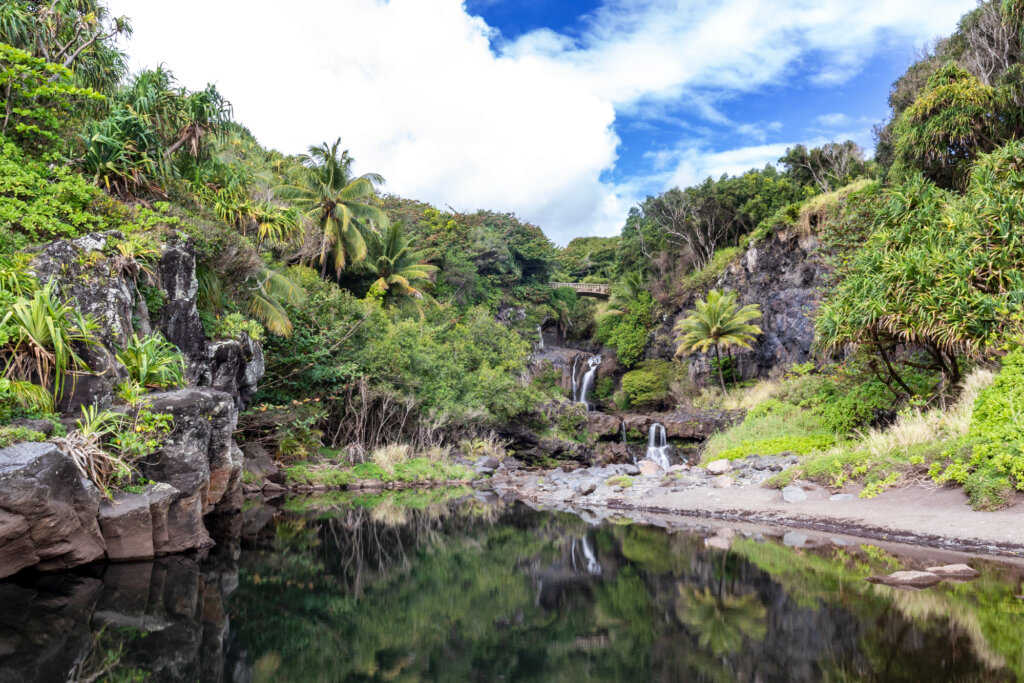
7. Iao Valley/Needle
The Iao Needle (Kuka’emoku, in Hawaiian) is another one of Maui’s famous landmarks. This distinctive peak shoots straight up 1200 feet!
In Hawaiian culture, it’s considered the phallic stone of Kanaloa, the ocean god (but weirdly, doesn’t look much like a phallus).
You’ll find the Iao Needle in Iao Valley State Park, the second wettest place in Hawaii (after Kauai).
It receives an average of an inch of rain per day. It’s a sacred place that used to be forbidden to all but Hawaiian royalty.
The park is somewhat compact and easy to walk, with the short hike to the Iao Needle being the main attraction here.
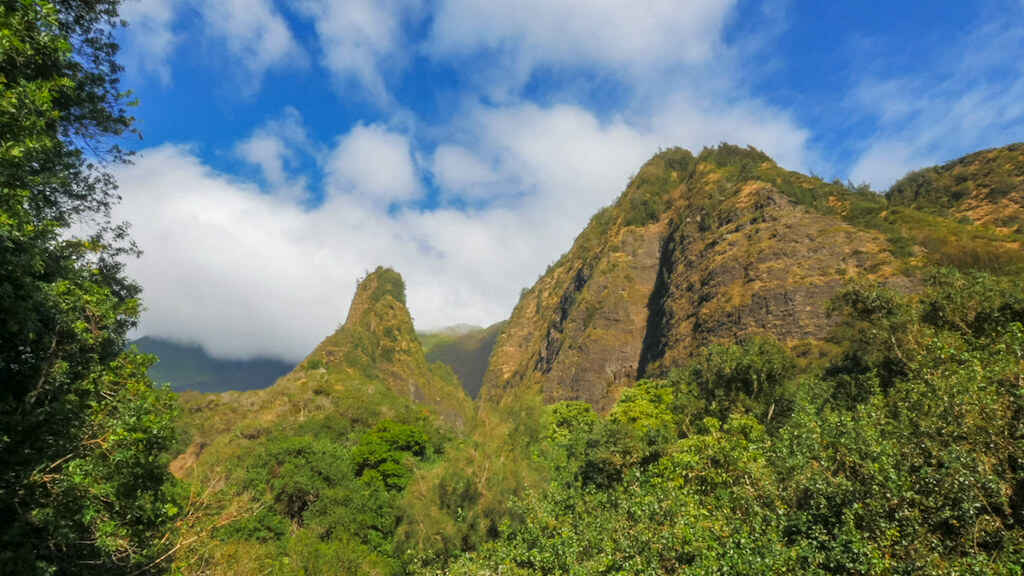
Kauai Landmarks
8. Nā Pali Coast
The Nā Pali Coast State Wilderness Park lies along the northwest section of the island here. And it’s dramatic.
These jagged green cliffs disappear into the clouds as the blue, blue Pacific Ocean spreads out below. These memorable cliffs are the most recognized landmark in Kauai.
There are three main ways to fully appreciate their scale and grandeur so at least one of them should be on your Kauai itinerary.
First, definitely take a sunset sail or snorkeling cruise along the north shore.
Then walk a section of the famous Kalalau Trail for a bird’s eye view of the stunning coast here. The trail is 11 miles and requires a reservation to hike the whole thing.
It’s a strenuous hike. But you can still enjoy a bucket list hike, even if you walk just the first half mile. The views are amazing here.
It’s steep though and climbs up, up, up. (Put hiking poles on your Kauai packing list and watch other hikers eye them longingly.)
And finally, head counter clockwise all the way around the island from the north shore, past Poipu, until you arrive at the Kalepa Ridge trailhead in Koke’e State Park.
No hiking required for the view below!
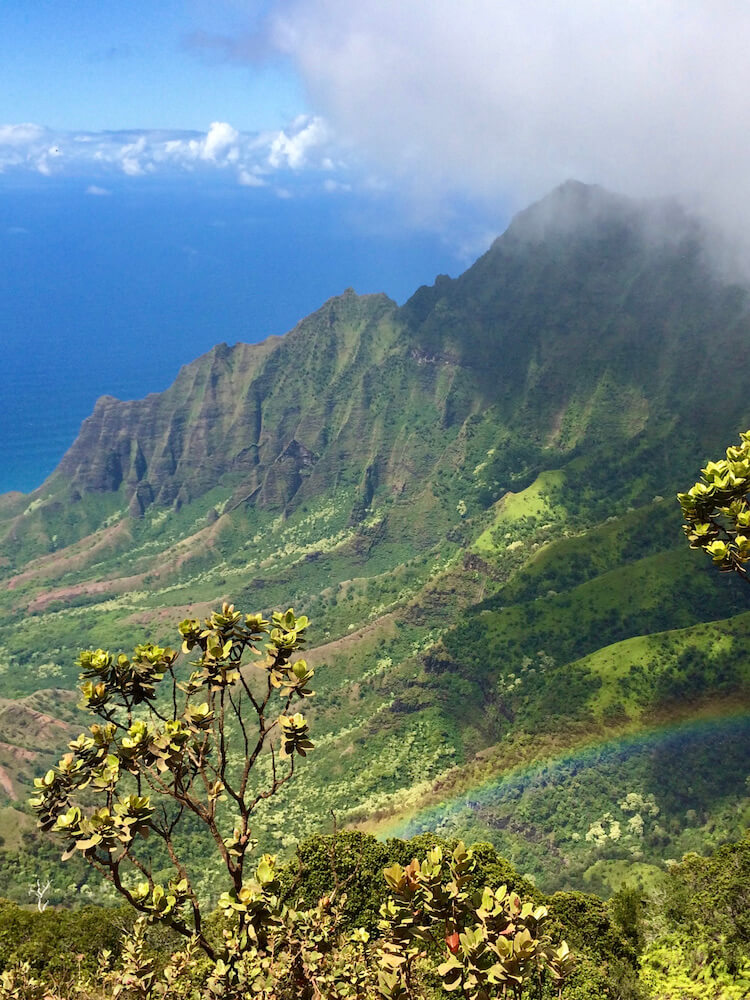
9. Waimea Canyon State Park
After you enjoy the view from the Kalalau Lookout Point, head into nearby Waimea Canyon State Park for a whole other kind of view.
With the moniker “Grand Canyon of the Pacific”, it’s easy to see where the comparison comes in. The large canyon here is 10 miles long and 3,000 feet deep!
There’s plenty of beautiful views of waterfalls flowing down steep verdant cliffs here. Stop at mile marker 10 for panoramic canyon views.
Or enjoy one of the many gorgeous hikes here. There’s one for every skill level. Just wear a hat and bring plenty of sunscreen and water. It’s exposed here.
It’s also really fun to enjoy an exhilarating downhill bike ride here!
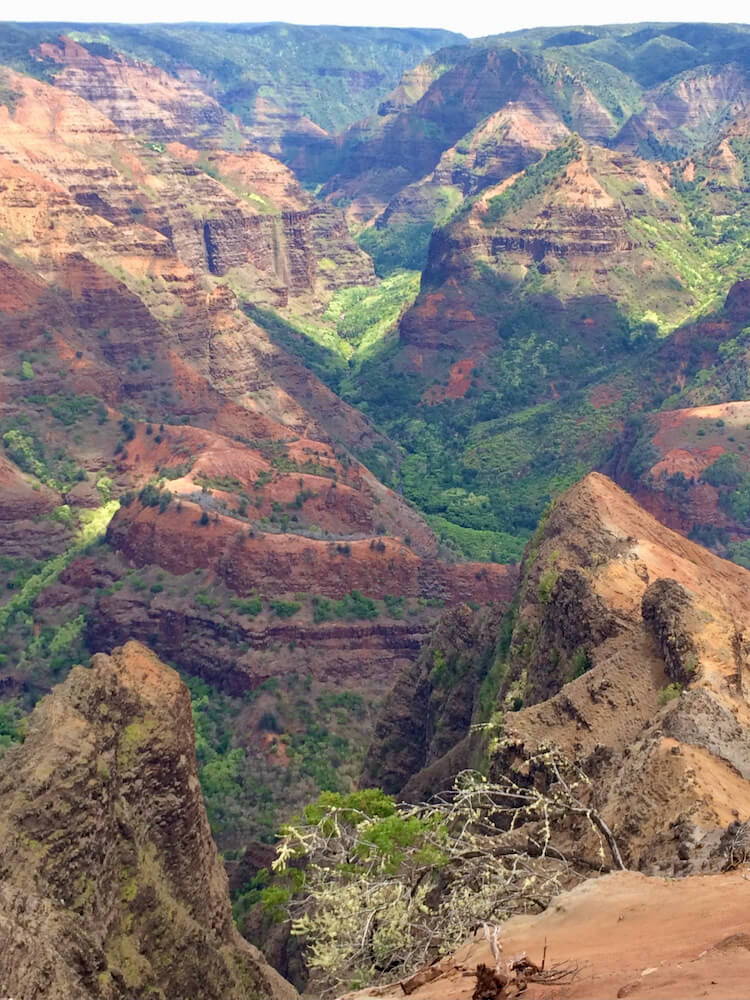
10. Queens Bath
You’ll find the unique Kauai landmark of Queen’s Bath in Princeville on the north shore here.
It’s essentially a tide pool which is actually a sinkhole surrounded by rock. And visiting is one of the top activities in Kauai.
To arrive here, you’ll need to hike down a muddy trail (includes some areas with ropes). Then you’ll emerge onto a lava shelf and eventually spy Queen’s Bath.
Do not go into Queen’s Bath! Despite the fact that many tourists float here, it’s dangerous. Rogue waves from the open ocean frequently wash visitors away.
So heed the dire warnings at the trailhead (often closed in winter due to high surf) and admire this beautiful spot from afar.
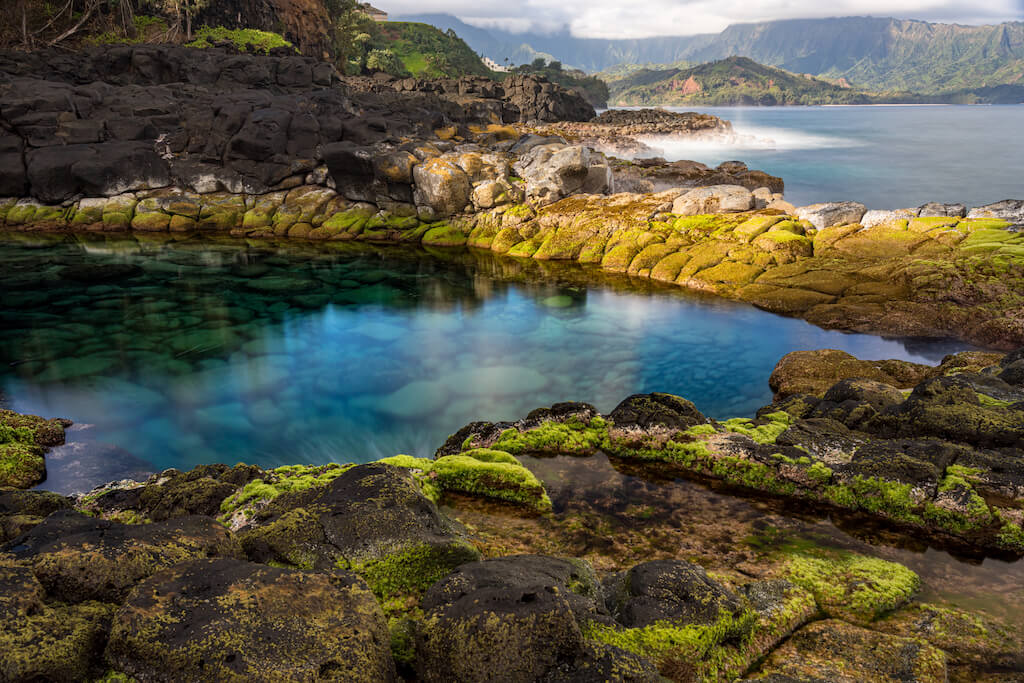
11. Wailua Falls
Wailua Fall drops 80 feet! It’s magnificent.
Not far from Poipu, this beautiful waterfall was once showcased in an episode of the TV series Fantasy Island.
There’s not much nearby but it’s definitely worth a visit and makes a great last stop on your way back to Lihue Airport (just 30 minutes away).
While you’re here, check out nearby Opaeka’a Falls. It’s a steeper drop than Wailua Falls and flows into a serene hidden pool.
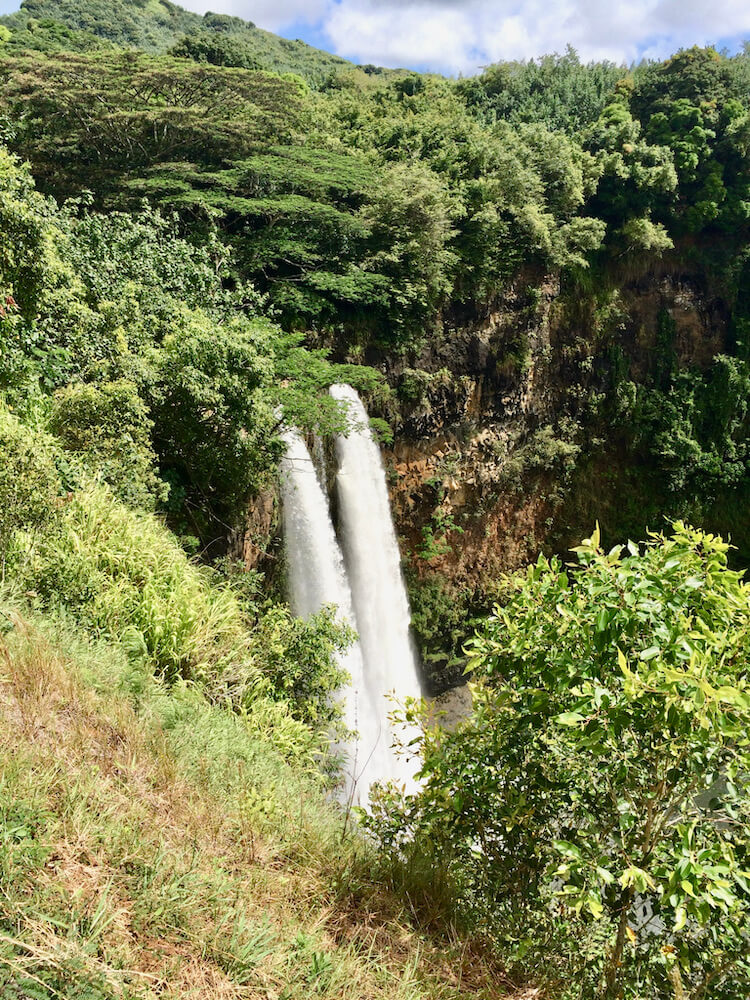
12. Hanalei Bay
Remember Puff the Magic Dragon? Who lived by the sea and frolicked in the autumn mist?
In a land called Hanalei?
You can experience this iconic spot for yourself at Hanalei Bay on Kauai’s north shore. Go kayaking and snorkeling here!
It’s featured in dozens of films as far back as 1957 and, more recently, in George Clooney’s The Descendants.
Hanalei Bay is the largest bay on the north shore here, with almost two miles of beach. It’s a great place to sail, swim, or go stand up paddle boarding.
After a visit, head into cute little Hanalei for a drink or a meal.
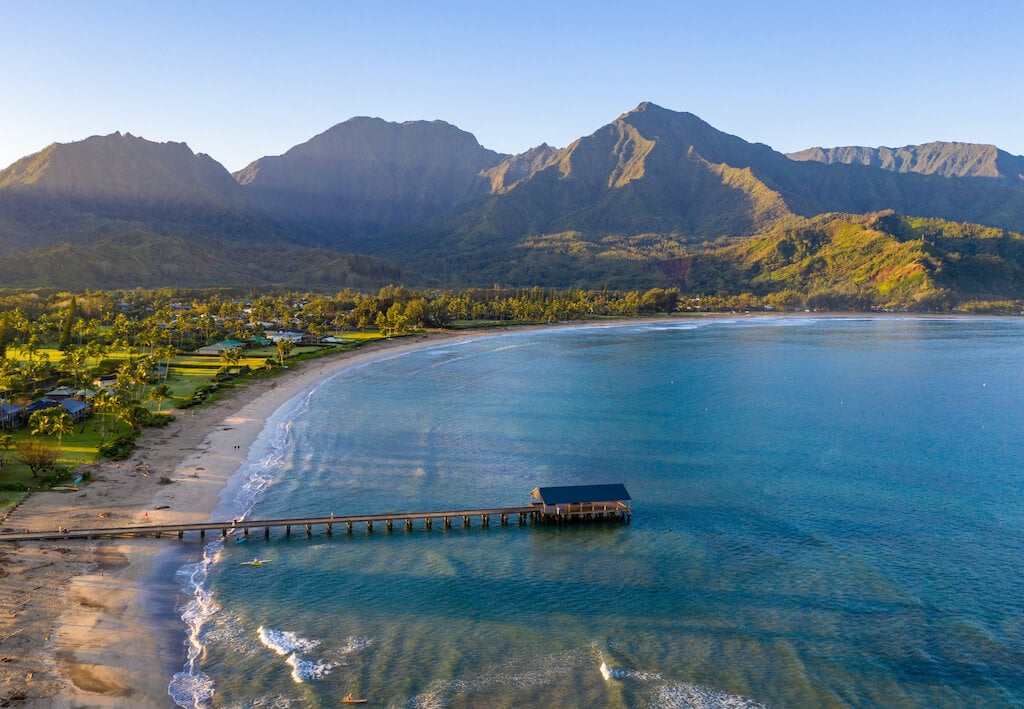
13. Kilauea Lighthouse
Another north shore Kauai landmark is the Kilauea Lighthouse, standing sentry in the Kilauea Point National Wildlife Refuge, not far from Princeville.
This historic lighthouse has been here since 1913. It’s 52 feet high and has earned its place on the National Register of Historic Places.
In fact, it played a role in guiding the first trans-Pacific flight from the west coast of the U.S. to Hawaii.
Just be aware that reservations are required to enter the wildlife refuge here to access the lighthouse. It’s all part of Hawaii’s new reservation system for accessing popular sites.
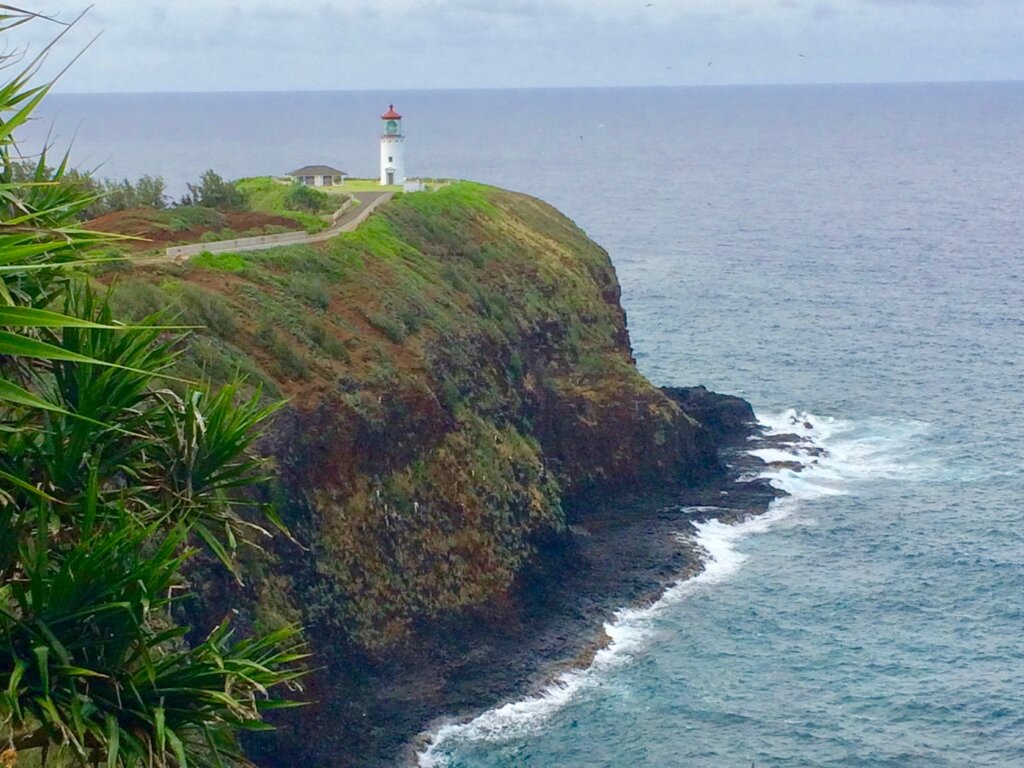
14. Limahuli Garden & Preserve
Tucked back near Tunnels Beach and the beginning of the Kalalau Trail on Kauai’s North Shore is the incredible Limahuli Garden & Preserve.
This is one of five National Tropical Botanical Gardens in Hawaii and Florida and features the largest group of native Hawaiian plant species anywhere.
It’s also one of the most biodiverse valleys in Hawaii and is home to many endangered plants and birds that are found nowhere else on earth!
Visitors today can visit the historic canoe gardens that showcase the plants that Polynesians first brought to Hawaii as well as native forests and rare and endangered plant species from northwestern Kauai.
It’s a lovely place to wander!
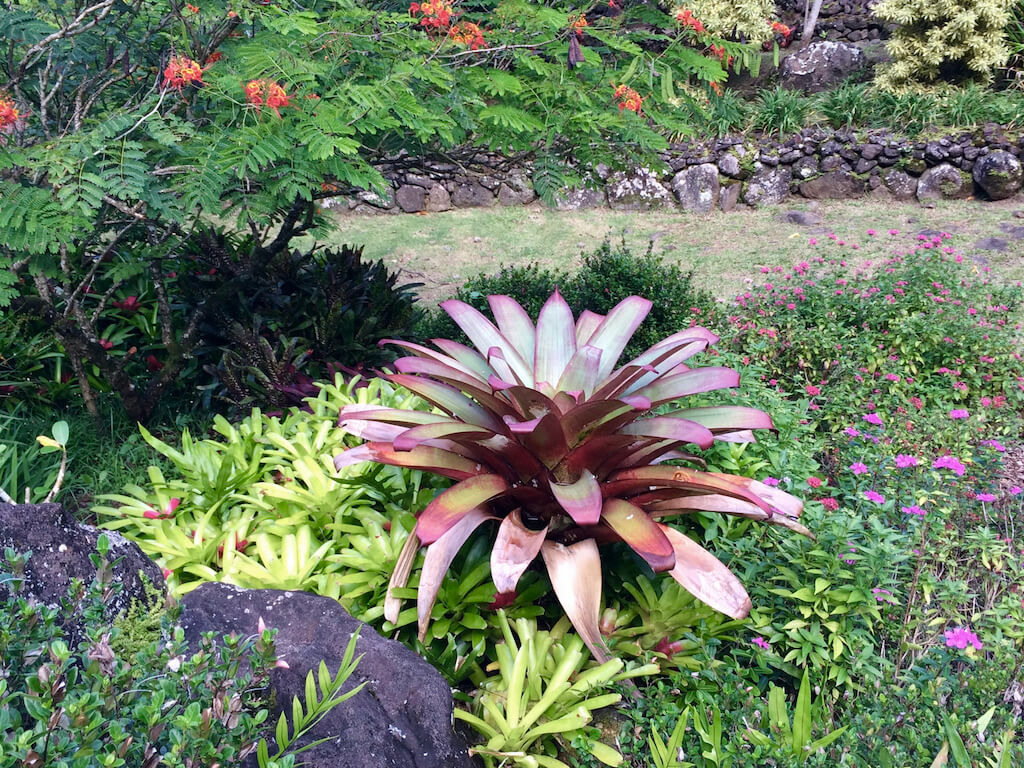
Oahu Landmarks
15. Diamond Head
The view from the top of Diamond Head has been gracing postcards for many decades. And it’s easy to see why…It’s possibly Hawaii’s most recognized landmark!
Diamond Head State Monument covers 475 acres when you include the interior and outer slopes of the massive saucer shaped crater that formed Diamond Head more than 300,000 years ago.
Today, you can climb to the summit for this incredible view of Honolulu and Waikiki Beach. It takes an hour or so as you climb ever higher until the double set of stairs at the end brings you the view below.
But get an early start! There are just 300 parking spots in the lot at the top of the mountain where the trail begins. Otherwise, you’ll be adding another 30 minutes uphill in the humidity.
Diamond Head is the most popular hike on Oahu.

16. Hanauma Bay
If Diamond Head is Oahu’s most popular hike, Hanauma Bay on the southeastern tip of the island is its most revered spot for snorkeling.
Hanauma Bay definitely belongs on every Oahu itinerary. However, only head here with an advance reservation. If you’d rather skip the driving and reservation hassle, book a driver.
As a protected reserve, the goal is to keep the reefs healthy here. Only 1,400 visitors are admitted daily and every visitor watches a brief video about how to preserve this special place.
The Hanauma Crater here was formed 32,000 years ago in the last round of volcanic activity to occur on the island.
Today, 400 species of tropical fish live in the fringe coral here as well as an abundance of Hawaiian green sea turtles.
It’s a stunning place. Just be sure to bring a hat and plenty of sunscreen as there’s very little shade.
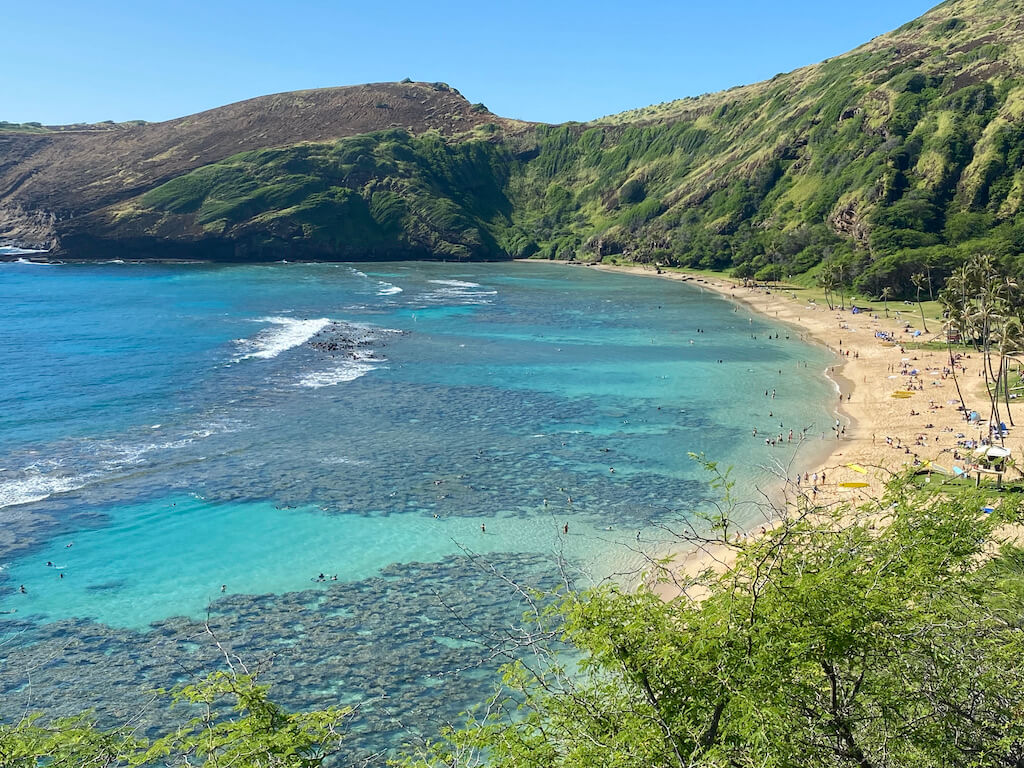
17. Byodo-In Temple
You’ll find the beautiful Buddhist Byodo-In Temple on Oahu’s scenic Windward Coast in Valley of the Temples Memorial Park.
It was dedicated in the late 1960s to commemorate the 100th anniversary of the very first Japanese immigrants who arrived on the Hawaiian islands. In 2019, National Geographic named the Byodo-In Temple one of the most beautiful Buddhist temples in the world.
Today, this lush paradise is a popular spot for weddings. It’s compact though so you’ll need just an hour to ogle the Koi pond, ring the Bon-sho (sacred bell), and perhaps sit in the peaceful meditation pavilion.
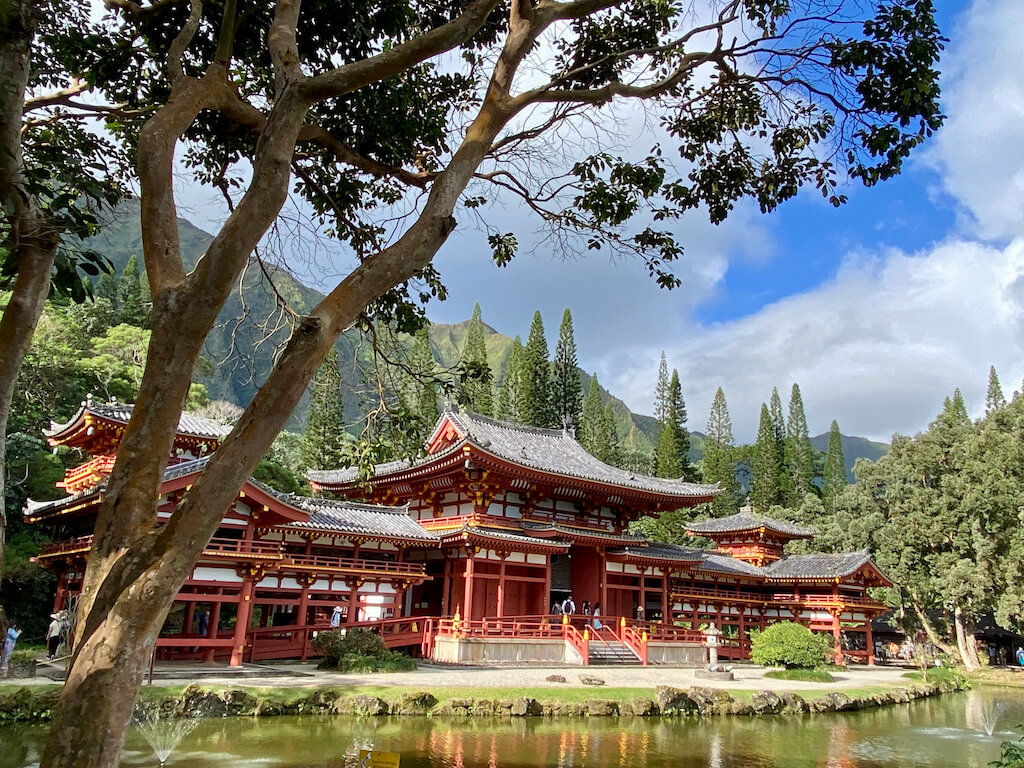
18. Shark’s Cove
Due to its abundance of fringe reefs, Oahu has some of the largest number of protected bays for swimming and snorkeling in Hawaii. And Shark’s Cove is the spot to snorkel on the north shore!
When the waves are calm, this small protected bay offers easy access to some of the most impressive marine life I’ve seen in Hawaii. Scuba Diving Magazine named it one of the 12 best shore dives in the world.
You’ll need to wind your way over the rocky black lava to gain access—and there can be a lot of people here—but once you’re in the water, you’ll hardly notice.
It’s an incredible spot. And the best North Shore food trucks are just across the street!
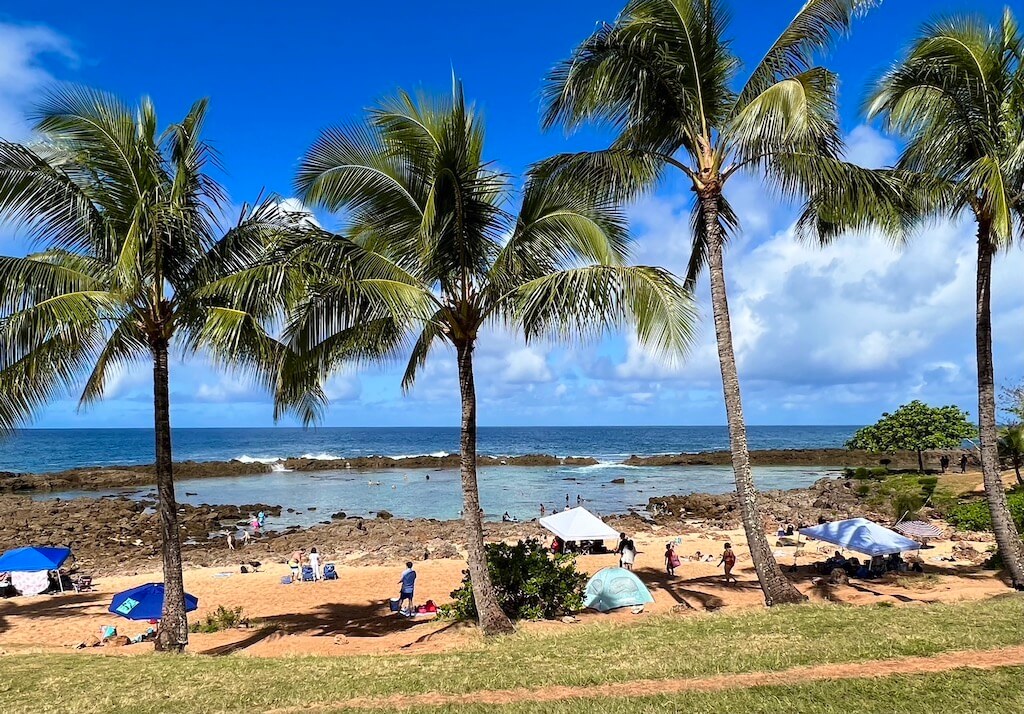
19. Pearl Harbor National Memorial
Pearl Harbor is one of the most important Hawaii landmarks to visit. After all, the surprise attack by Japanese bombers in December 1941 changed the course of history.
It’s a moving experience to pay your respects here. You’ll head out on a navy shuttle boat to the USS Arizona Memorial, the resting place of more than 1,100 sailors and marines killed on that fateful day.
All these years later, you can still see the oil leaking from the ship into the water.
Somewhere between 14,000 and 64,000 gallons of oil have leaked since the attack and it’s estimated it may continue to leak for another 500 years…a poignant symbol of grief for the lives lost here.
We found the museum audio guide a little underwhelming. I’d recommend a guided Pearl Harbor tour for the full experience.
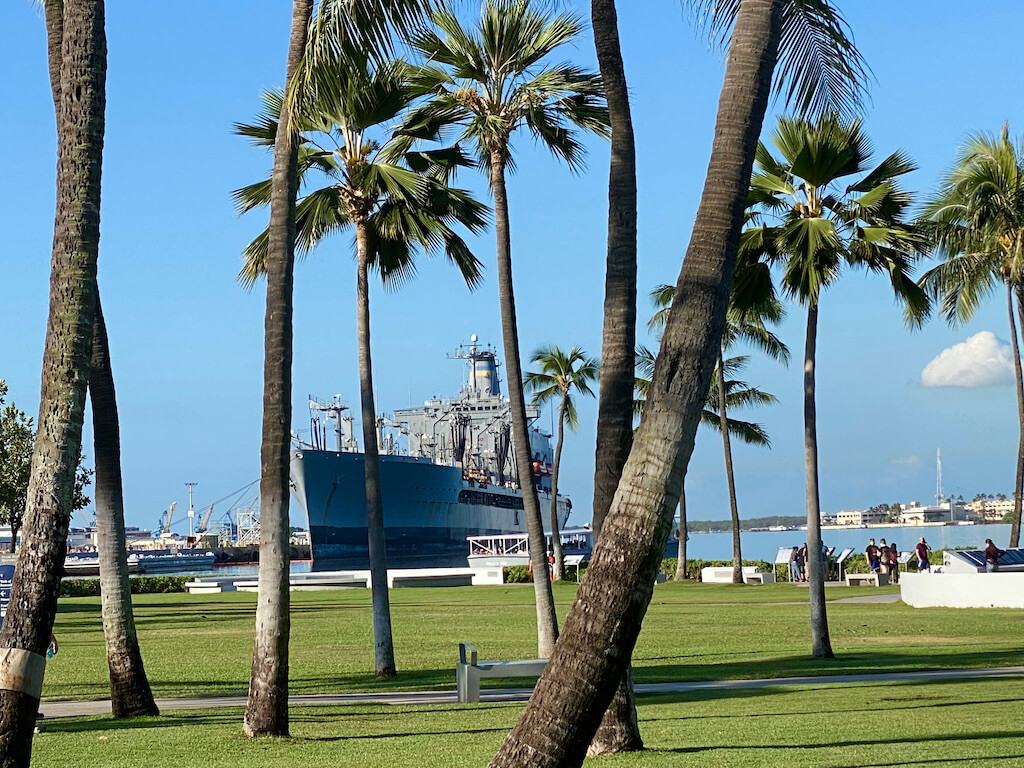
20. Ioni Palace
As the official residence of Hawaii’s monarchy, the Ioni Palace is an important Honolulu landmark as well as a registered National Historic Landmark. It’s also the only official royal palace in the whole USA.
As you walk the meticulously restored halls and grounds here, you’ll feel like you’ve stepped back in time when King Kalakua and his sister (and successor) Queen Liliuokalani reigned here.
The palace grounds here are thought to be the site of an ancient heiau or “place of worship”, in antiquity.
During the restoration, and since, everything from porcelain plates to chairs have been recovered from 36 states and four foreign countries.
Originally sold at auction, objects original to the palace were scattered around the world and are still finding their way home yet today.
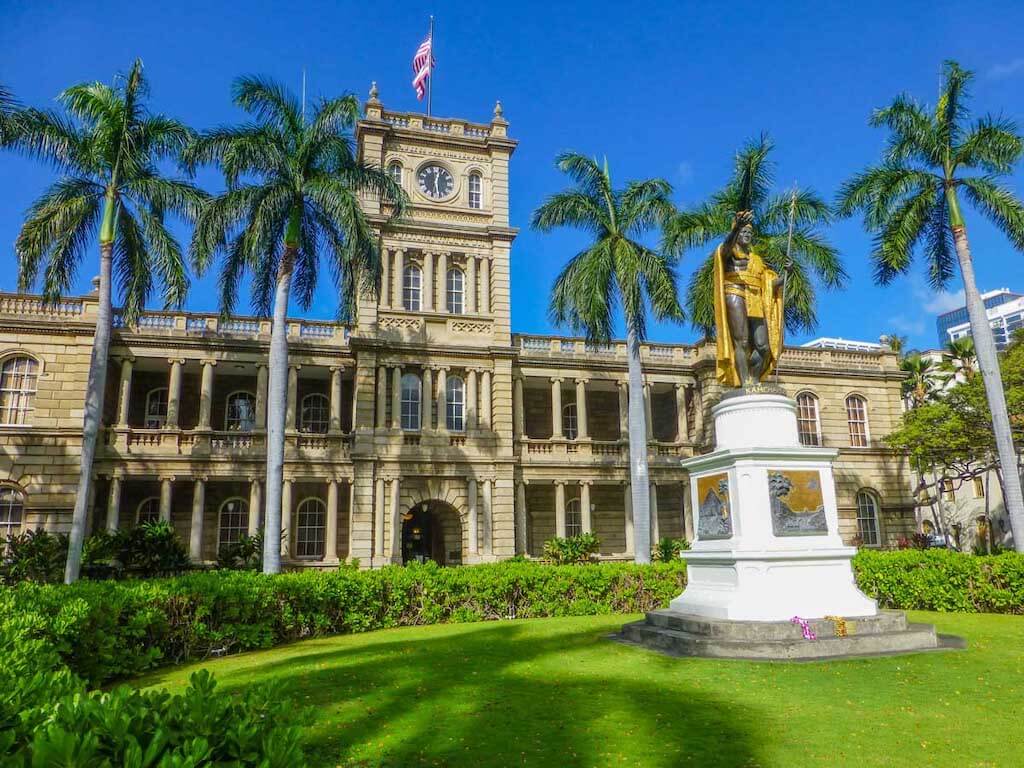
21. Dole Plantation
The famous Dole Plantation has been serving up pineapple for the world since its humble beginnings as a fruit stand in 1950!
Today, the plantation is famous for its Pineapple Garden Maze (which earned an entry in the 2009 Guinness World Records) as well as its whistle stop train tour and educational events celebrating centuries of Hawaiian agriculture, traditions, and craft.
To try here: Ice-cold DoleWhip, a proprietary soft serve dairy-free frozen dessert.
If you’re looking for a fun Oahu day trip without a car, this is a great place to enjoy a guided day tour.
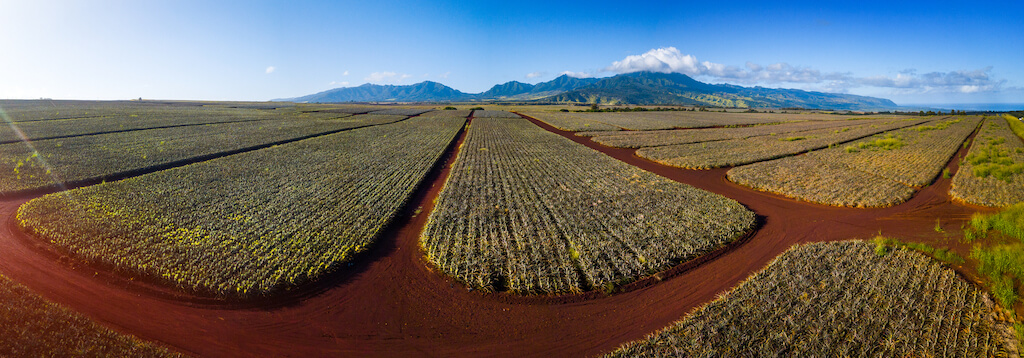
22. Waimea Valley
Waimea Valley is an absolutely stunning botanical garden on Oahu’s north shore. It’s also full of Hawaiian history.
Polynesian voyagers arrived in double-hulled canoes here in Waimea as early as 1902 AD and chose this lush valley for its excellent geographic location and free-flowing streams. It was home to Kahuna Nui (high priests).
You can still see many significant sites and places of worship here today. Careful restorations offer an authentic glimpse into ancient Hawaiian life through traditional huts, shrines, and sacred sites.
To do here: Take an easy, scenic two mile hike to beautiful Waimea Falls. Don’t forget your bathing suit as you can swim in the waterfall!
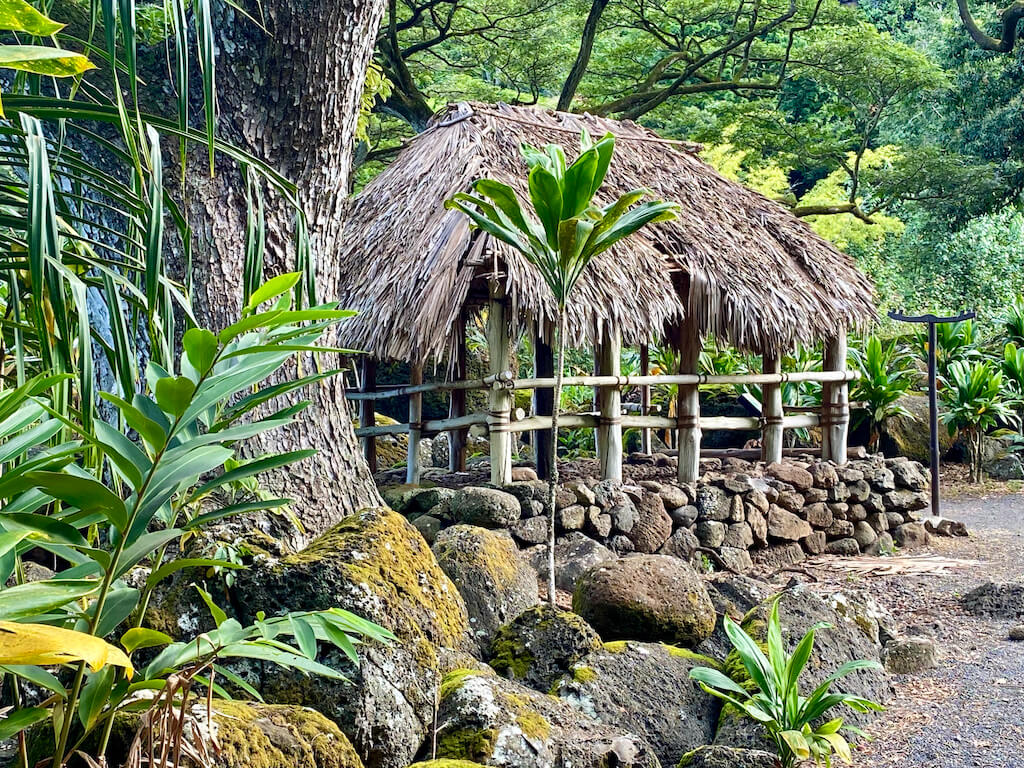
23. Ko Olina
About a 30 minute drive from Honolulu lies the lovely resort enclave of Ko Olina…642 acres of sweeping mountain views.
The distinctive landmark here in Ko Olina is a string of four incredibly scenic manmade lagoons. Each comes with a sandy beach and is connected to the others with a coastal walkway. There’s nowhere better to be at sunset!
Ko Olina makes a great base on the southern end of Oahu for those looking for more peace and resort amenities than in Honolulu.
You’ll find Aulani, Disney, Four Season, Marriott’s Ko Olina Beach Club and the Beach Villas all nestled up to the lagoons here.
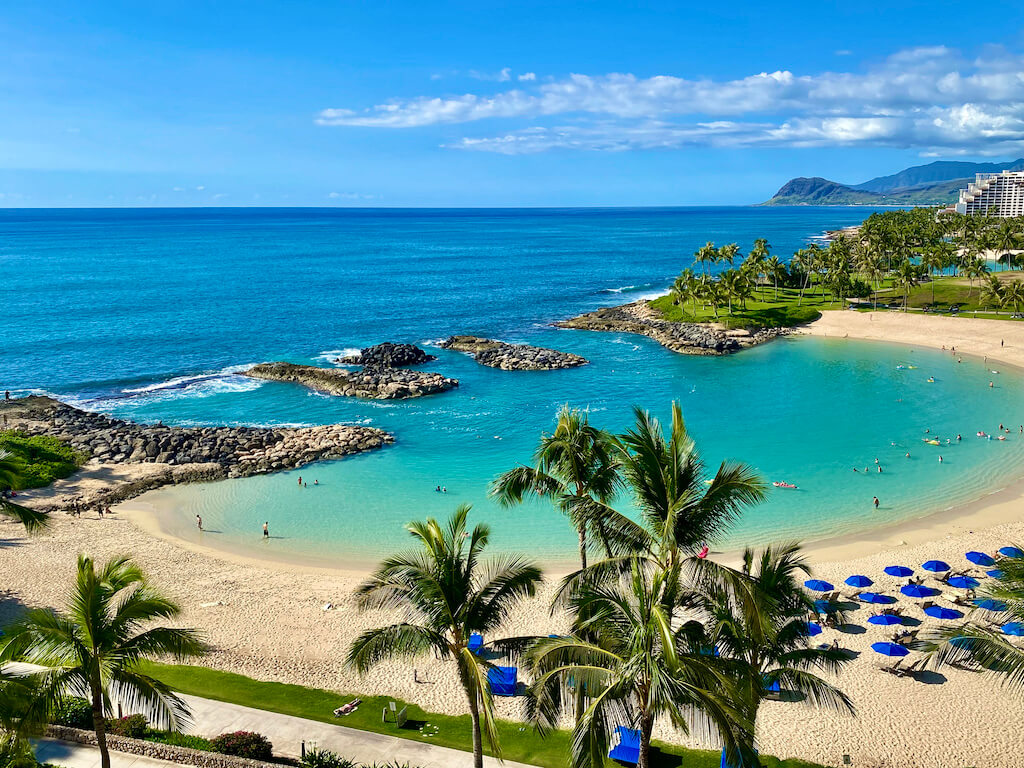
24. Waikiki Beach
Who hasn’t heard of famous Waikiki Beach in Honolulu?
This natural golden sandy beach stretches two continuous miles along the coast. Gentle waves make it the perfect place for beginning surfers.
Back in the early 19th century, Hawaiian royalty surfed here on early longboards. Fast forward to the early 20th century when Duke Kahanamoku’s Olympic surfing fame brought new surfers to Waikiki from around the world.
Today, you’ll find Waikiki to be a tourist hotspot and nearby neighborhoods full of glam hotels and high end boutiques. Head here to see surf competitions, hula dancing, and outrigger canoe races.
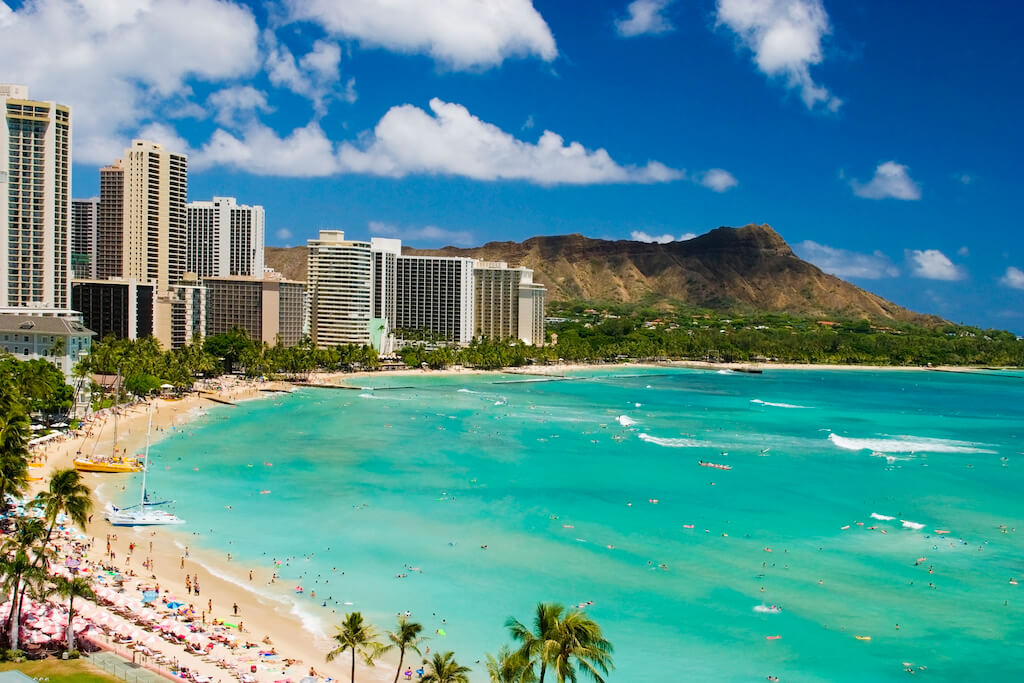
25. Polynesian Cultural Center
The Polynesian Cultural Center is a living museum on north Shore Oahu. It’s also one of the most visited landmarks in the Hawaiian islands with more than 70,000 visitors per year.
Over 42 acres, visitors can get a glimpse of Hawaiian culture through demonstrations, exhibits, and arts and crafts in eight tropical villages that simulate Polynesian cultures…Hawaii, Samoa, New Zealand, Fiji, Tahiti, and Tonga.
Other events include an evening multicultural Polynesian show and a parade of canoes. A luau and marketplace complete the experience.

Big Island Landmarks
26. Volcanoes National Park
Hawaii Volcanoes National Park is like no other national park in the U.S.!
In fact, this park is a designated International Biosphere Reserve and UNESCO World Heritage Site. It’s also the Big Island’s best known landmark.
The 323,000 acre park includes two volcanoes: Kilauea and Mauna Loa. These volcanoes do continue to erupt on and off. Lucky travelers who time their visit right can watch molten lava pour into the sea or sky here!
As of April 2022, the eruption for the crater of Kilauea can be seen from Old Crater Rim Drive Trail.
Hikes here lead visitors through rain forests, moonscapes, and lava tubes as steam vents all over send misty puffs of steam into the sky.
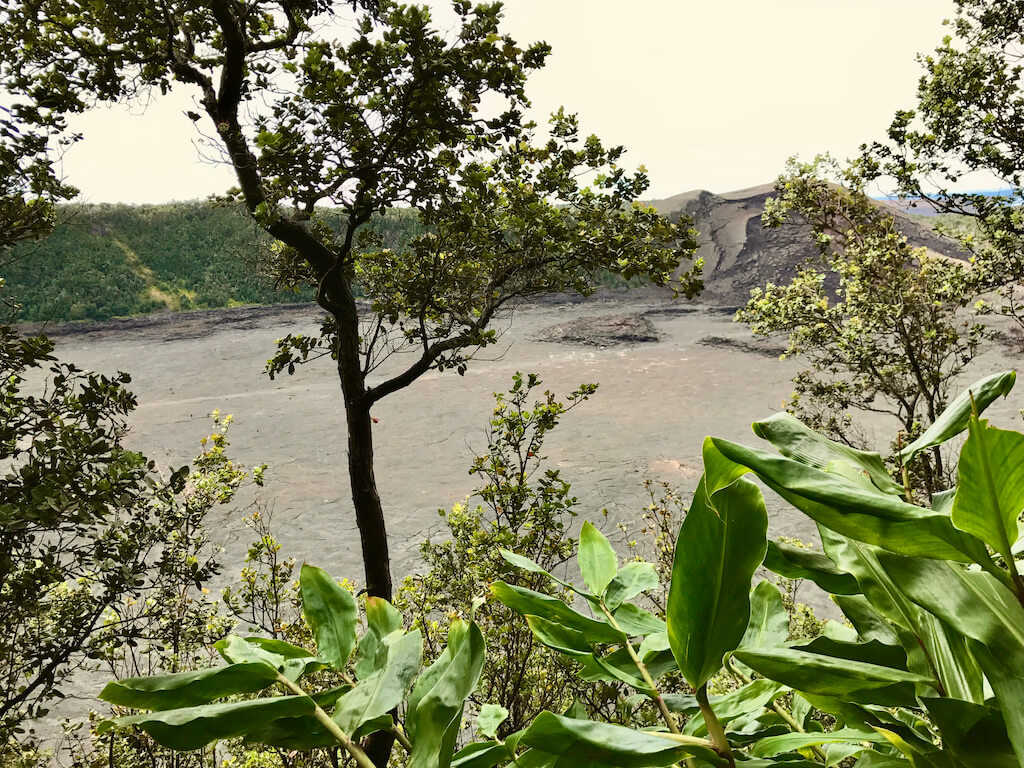
27. Place of Refuge
Place of Refuge, or Puʻuhonua o Hōnaunau National Historical Park in Hawaiian, is a beautiful spiritual sanctuary near Kealakekua Bay on Big Island.
In ancient times, this was a refuge and safe haven for those who broke Kapu laws, such as eating with a member of the opposite sex or touching anyone or anything belonging to a highborn chief. These kapu were otherwise punishable by death.
Wander the Royal Grounds here and see the reconstructed Halalau that sheltered canoes. See the sacred Hale o Keawa Temple, built in the 17th century.
Study the many Ki’i—carved wooden statues—of Hawaiian gods here. It’s a unique and special place.
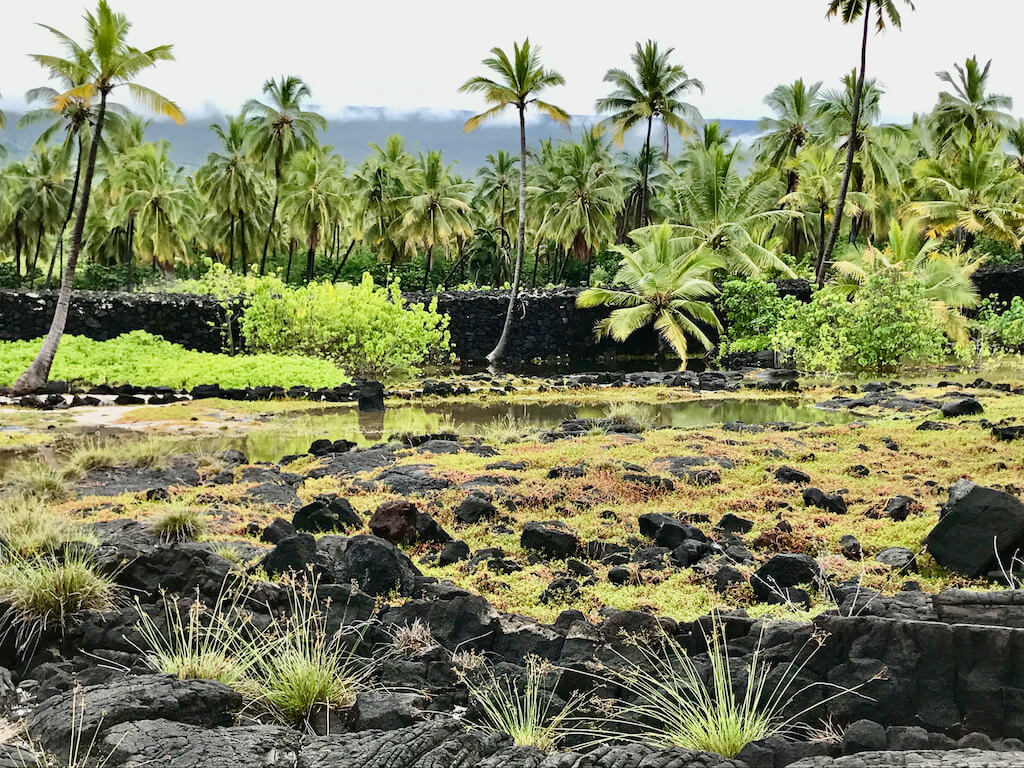
28. Kealakekua Bay
Kealakekua Bay near Kona, on Big Island’s west coast, is a Marine Life Conservation District and favored by snorkelers the world over.
The bay is part of the Kealakekua Bay State Historical Park, which is also home to the famous Captain Cook Monument and landmark.
The statue at the edge of the water here commemorates the occasion where Captain James Cook, the very first westerner, landed on the island. In fact, he was also the first British explorer to make any contact with the Hawaiian islands (which occurred on Kauai).
Because Kealakekua Bay is so popular, it’s not possible to snorkel or swim here unless you book a snorkeling day tour.
This is a welcome conservation measure to protect this unique and special place from overtourism.
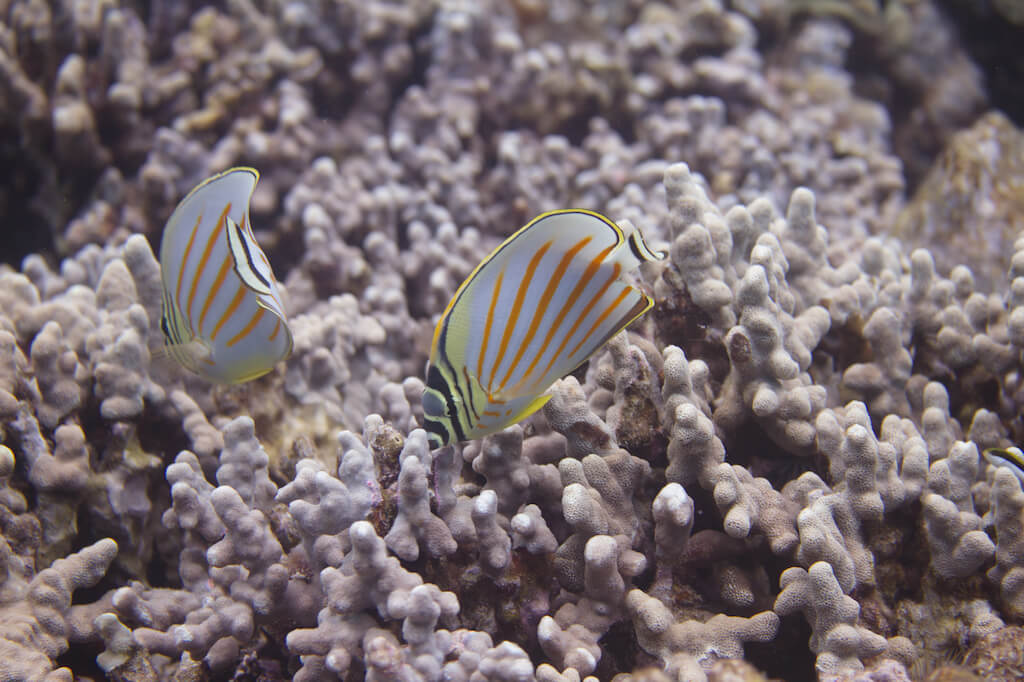
29. Akaka Falls
There are plenty of waterfalls in Hawaii, but Akaka Falls in Akaka Falls State Park near Hilo, on the east side of the island, is an important natural landmark.
It’s possibly Hawaii’s most famous waterfall! And that’s saying something.
The falls flows 442 feet down into a stream-eroded gorge here and you can see it in under an hour by following the easy and scenic paved trail out and back.
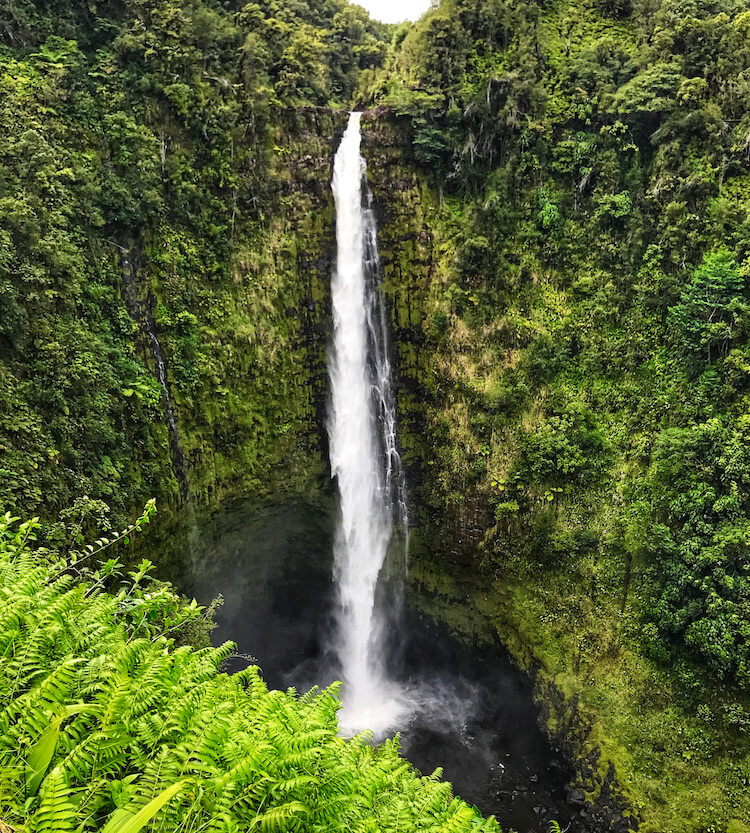
30. Waipio Valley
Waipio Valley is a remote and beautiful Big Island landmark located north of Hilo on the northeastern side of the island. “Waipi’o” means “curved water” in Hawaiian.
It’s another place of unique cultural significance: the ancient grass palace of ancient Hawaiian kings was located here.
Once upon a time, Waipio Valley was very populated but today it’s wild with taro fields.
Unfortunately, today, Waipio Valley Road—the main access point—is closed to visitors due to concerns about erosion.
Head instead to the Waipi’o Lookout for views. Otherwise, if you’re fit and up for a challenge, take the 6.5 mile out and back trip down to the black sand beach here.
It’s practically a near vertical descent and ascent, however, so it’s not for the faint of heart!
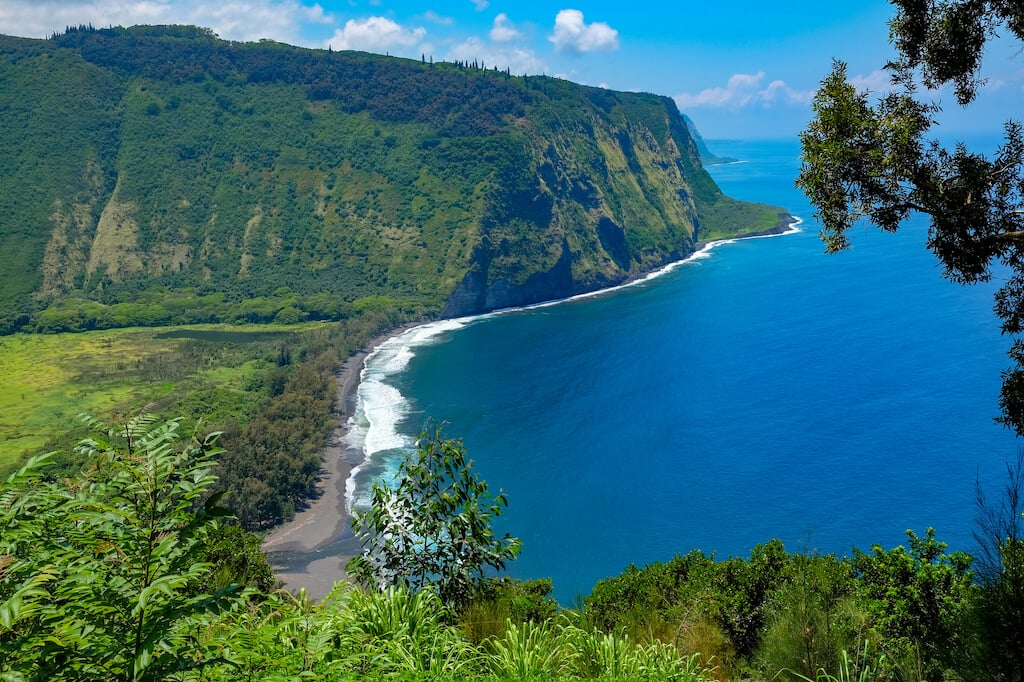
31. Hawaii Tropical Botanical Garden
Hawaii Tropical Botanical Garden, also north of Hilo, is my favorite botanical garden in Hawaii.
Back in the late 70s, when it was still an overgrown jungle known as the Onomea Valley, a nature lover and his assistant purchased the parcel and set about cultivating, collecting, and planting more than 2,500 tropical and subtropical plants from around the globe.
Today, this living classroom draws photographers, gardeners, botanists, and nature lovers worldwide to wander the waterfalls, ogle the ocean vistas, and gasp at the incredible plant life here.
Don’t miss Hawaii Tropical Garden!
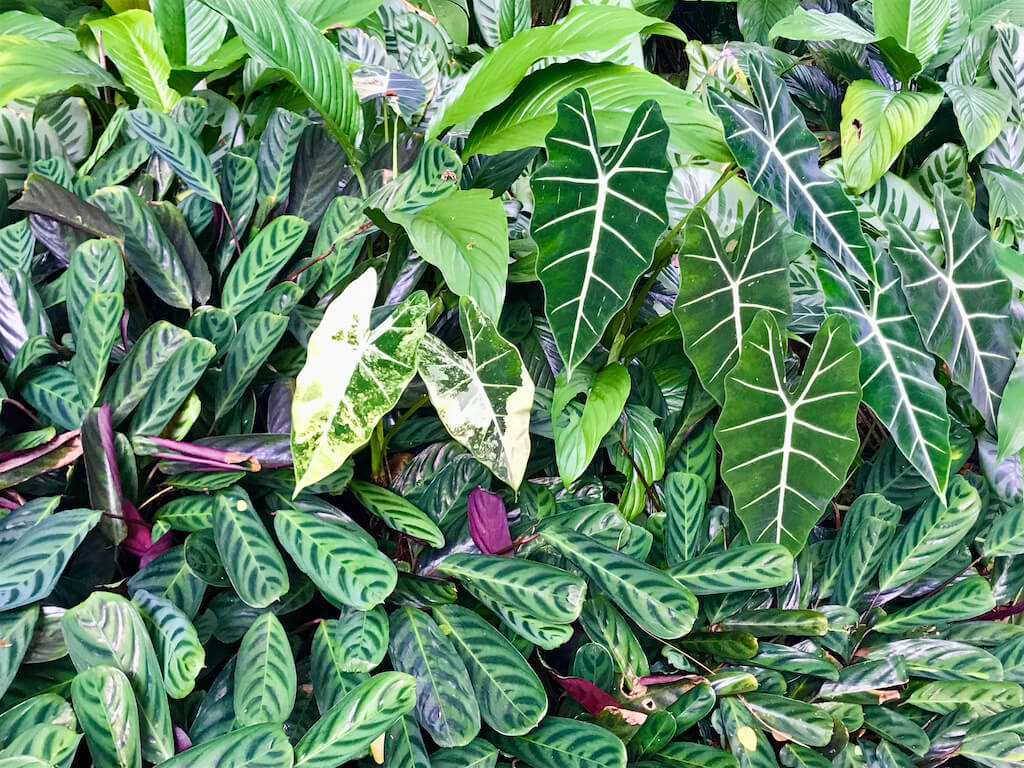
32. Mauna Kea
Mauna Kea, best accessed in the center of Big Island, is dormant. It’s the island’s oldest volcano and is now extinct according to some. Others, say it’s likely to erupt again.
With a peak at 13,803 feet above sea level, it’s the highest point in the state of Hawaii and the second highest peak of an island anywhere on earth!
How’s that for a landmark?
The best reason to head to Mauna Kea is for unparalled stargazing opportunities here. There’s often snow and wind, however, so bundle up and arrive in time for sunset.
Then head to the Mauna Kea Observatory. Or book a stargazing tour for an opportunity to peak through the telescope.
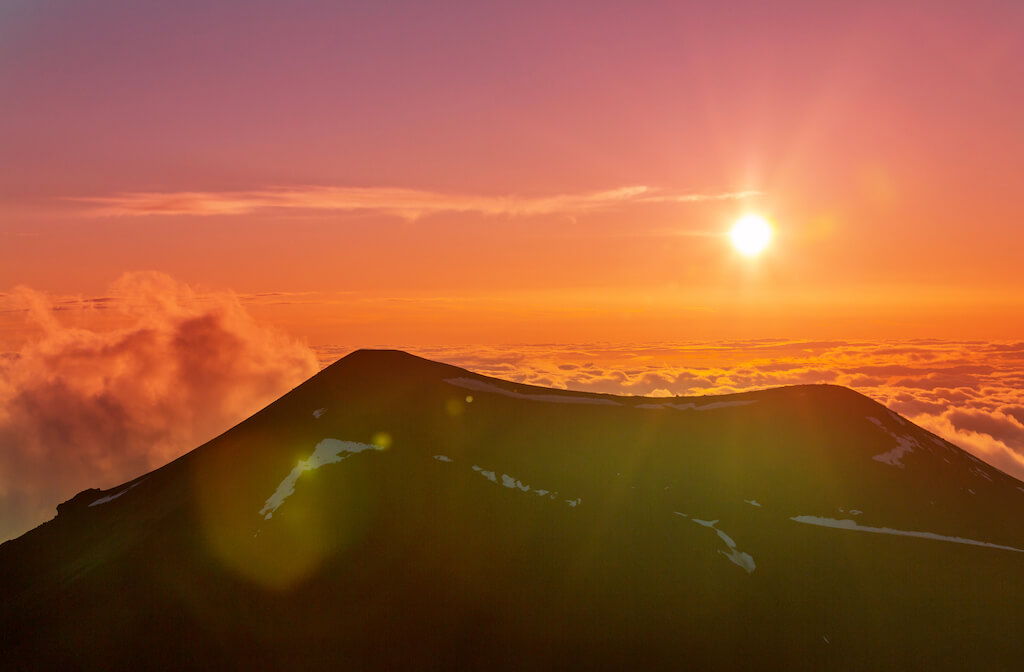
Like this post? Pin it to save it for later!

Leave a Reply